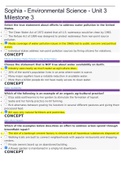NR565 ADVANCED PHARMACOLOGY FUNDAMENTALS
WEEK 5, Week 6 Week 7 &Week 8
• Signs and Symptoms of hypothyroidism and hyperthyroidism
• Hypothyroidism: The face is pale, puffy, and expressionless. The skin is cold and
dry. The hair is brittle, and hair loss occurs. Heart rate and temperature are
lowered. The patient may complain of lethargy, fatigue, and intolerance to cold.
T4 and T3 are lower while TSH is higher
• Hyperthyroidism: Heartbeat is rapid and strong, and dysrhythmias and angina
may develop. Nervousness, insomnia, rapid thought flow, and repaid speech.
Increased heat production, increased body temperature, intolerance to heat,
and skin that is warm and moist. Appetite is increased. Exophthalmos. T4 and
T3 are higher while TSH is lower.
• What adjunctive therapy is good to prescribe to control symptoms of
hyperthyroidism other than thyroid specific medications. Know drug
classes and examples of those drug classes.
• Beta Blockers and nonradioactive iodine may be used. Beta Blockers suppress
tachycardia and nonradioactive iodine inhabit synthesis and release of thyroid
hormones.
• Monitoring needs and intervals for thyroid medications
• Levothyroxine: Obtain baseline TSH and free T4. Monitor TSH 6-8 weeks after
initiating therapy and after any dosage change. Check yearly after stable.
• Methimazole: Obtain serum levels of TSH, free T3, and free T4. Check baseline
CBC and LFTs before starting. Monitor CBC with differential if signs or symptoms
of infection. Check LFTs if sings or symptoms of liver dysfunction.
• Propythiouracil (PTU) carriers a risk for liver toxicity. Although rare, the FDA
recommends against using PRU as a first-line treatment due to potential for
hepatic toxicity
• Effects of maternal hypothyroidism on offspring and appropriate patient teaching
related to need for treatment.
• Maternal hypothyroidism can decrease IQ and other neuropsychological
function, typically in the first trimester. Should be monitored and treated early.
When taking thyroid supplements prior, dosage requirements usually increase.
• Patient teaching for thyroid medications
• Levothyroxine: Take in the morning at least 30-60 minutes before eating. Do
not switch brands because they could have different levels.
• What drug class can interfere with the assessment and monitoring of
diabetes and why?
• You will need to connect pathophysiology information of medications and
diabetes together. Think about alpha and beta cells.
• Beta blockers mask the signs of hypoglycemia because the beta-blockade
impairs glycogenolysis and can make insulin-induced hypoglycemia even
worse.
• Thiazide diuretics, glucocorticoids, sympathomimetics can counteract the effects
of insulin.
,• HgbA1C goals—what are they generally? Review goal guidelines for different
age groups within the ADA DM Guidelines linked in the Endocrine Case Studies.
• An A1C goal for many nonpregnant adults of ,7% (53 mmol/mol) is appropriate.
, • On the basis of provider judgment and patient preference, achievement of lower
A1C levels (such as ,6.5%) may be acceptable if this can be achieved safely
without significant hypoglycemia or other adverse effects of treatment.
• Less stringent A1C goals (such as ,8% [64 mmol/mol]) may be appropriate for
patients with a history of severe hypoglycemia, limited life expectancy,
advanced microvascular or macrovascular complications, extensive comorbid
conditions, or long-standing diabetes in whom the goal is difficult to achieve
despite DSME, appropriate glucose
• A reasonable A1C target for most children and adolescents with type 2
diabetes treated with oral agents alone is ,7%
• Review diagnostic criteria and process for Diabetes
Table 48.2 Criteria for the Diagnosis of
Diabetes Mellitus
Fasting plasma glucose >126mg/dL Or
Random plasma glucose >200 plus
symptoms
Or
Oral glucose tolerance test: 2-h plasma
glucose >200mg/dL
Or
Hemoglobin A1C 6.5% or higher
• Know mechanism of action and contraindications for DM drug classes
• Know examples of DM drug classes
Table 48.9 Drugs for Type 2 Diabetes
Class and Specific Actions Major Adverse Effects Contraindications
Agents
Biguanide Decreases glucose GI symptoms, Renal insufficiency:
(Metformin) production by the liver, decreased appetite, can cause it to
increases tissue N/ D, lactic acidosis accumulate rapidly
response to insulin
Second Gen Promote insulin Hypoglycemia, weight
Sulfonylureas secretion by the gain
(Glipizde) pancreas; may also
increase tissue
response to insulin
Meglitinides Promote insulin section Hypoglycemia, weight
(Glinides by the pancreas gain
Thiazolidinediones Decrease insulin Hypoglycemia but In Pioglitazone, Heart
(Glitazones) resistance and thereby only in the presence Failure
increase glucose of excessive insulin,
uptake by muscle and HF, bladder cancer,
adipose tissue and fractures, ovulation
decrease glucose
production by the liver





